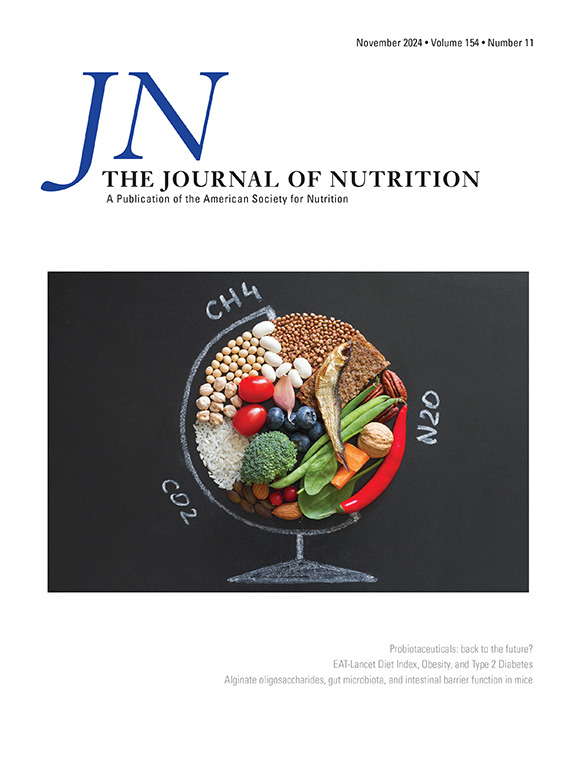膳食酚类化合物与成人代谢综合征房颤风险生物标志物之间的关系:一项纵向分析
IF 3.7
3区 医学
Q2 NUTRITION & DIETETICS
引用次数: 0
摘要
酚类化合物(PC)可能由于其抗炎和抗氧化作用而降低心血管疾病的风险。研究地中海代谢综合征人群中膳食总PC摄入量与房颤(AF)风险生物标志物之间的关系可能为房颤生理病理提供新的见解。目的:本观察性研究旨在分析来自PREDIMED-Plus试验的566名参与者5年内总PC摄入量与血清中5种af相关生物标志物水平之间的关系。方法:在代谢综合征患者(平均年龄:65.1岁,女性40.4%)中,在基线、3年和5年测量血液生物标志物:n端前b型利钠肽(NT-proBNP)(心房拉伸)、高敏肌钙蛋白T (hs-TnT)(心肌损伤)、高敏c反应蛋白(hs-CRP)(炎症)、前胶原1型羧基端前肽(PICP)(纤维化)和3-硝基酪氨酸(3- nt)(氧化应激)。使用经过验证的143项食物频率问卷和酚- explorer数据库评估PC摄入量。用多变量调整混合线性模型评估对数转换生物标志物水平的变化。还评估了个人之间PC总摄入量差异的来源。结果:5年多来,中高基线PC摄入量(四分位数2-4)的参与者显示39.5% (95%CI 27.4%;52.6%;结论:我们的研究结果表明,较高的PC摄入量与NT-proBNP浓度的较大增加有关。在接受ILI和高PC摄入量的参与者中,发现其- tnt水平的增加较低。未来的研究有必要更好地了解膳食摄入PC在af相关途径中的作用。本文章由计算机程序翻译,如有差异,请以英文原文为准。
Associations between Dietary Phenolic Compounds and Biomarkers of Atrial Fibrillation Risk in Adults with Metabolic Syndrome: A Longitudinal Analysis
Background
Phenolic compounds (PCs) may reduce the risk of cardiovascular disease due to their anti-inflammatory and antioxidant effects. Examining relationships between dietary intake of total PC and atrial fibrillation (AF) risk biomarkers in a Mediterranean population with metabolic syndrome may offer new insights about AF physiopathology.
Objectives
This observational study aimed to analyze the relationship between total PC intake and serum concentrations of 5 AF-related biomarkers over 5 y in 566 participants from the PREDIMED-Plus trial.
Methods
In participants with metabolic syndrome (mean age: 65.1 y; 40.4% women), the following blood biomarkers were measured at baseline and at 3 and 5 y: N-terminal pro–B-type natriuretic peptide (NT-proBNP; atrial stretch), high-sensitivity troponin T (hs-TnT; myocardial damage), high-sensitivity C-reactive protein (hs-CRP; inflammation), procollagen type 1 carboxy-terminal propeptide (PICP; fibrosis), and 3-nitrotyrosine (NT; oxidative stress). PC intake was assessed using a validated 143-item food frequency questionnaire and the Phenol-Explorer database. Changes in log-transformed biomarkers concentrations were evaluated with multivariable-adjusted mixed linear models. Sources of between-person variability in total PC intake were also evaluated.
Results
Over 5 y, participants with moderate-high baseline PC intake (quartiles 2–4) showed a 39.5% (95% CI: 27.4%, 52.6%; P < 0.001) increase in NT-proBNP concentrations compared to a 20.5% (95% CI: 3.4%, 40.3%; P = 0.03) increase in the lowest quartile (Ptime × categories = 0.04). When PC intake was updated over follow-up, moderate-high intake showed a 32.2% (95% CI: 19.5%, 46.2%; P < 0.001) increase in NT-proBNP compared to a 27.3% (95% CI: 6.5%, 52.1%; P = 0.004) in the lowest quartile, (Ptime × categories = 0.02). Participants with moderate-high PC intake undergoing intensive lifestyle intervention showed smaller increases in hs-TnT than those with lower intake. Chocolate was the main contributor to between-person variability in PC intake.
Conclusions
Our results show that higher PC intake was associated with larger increases in NT-proBNP concentrations. In participants undergoing an intensive lifestyle intervention and higher PC intake, a lower increase in hs-TnT concentrations was found. Future research is warranted to better understand the role of dietary intake of PC in AF-related pathways.
求助全文
通过发布文献求助,成功后即可免费获取论文全文。
去求助
来源期刊

Journal of Nutrition
医学-营养学
CiteScore
7.60
自引率
4.80%
发文量
260
审稿时长
39 days
期刊介绍:
The Journal of Nutrition (JN/J Nutr) publishes peer-reviewed original research papers covering all aspects of experimental nutrition in humans and other animal species; special articles such as reviews and biographies of prominent nutrition scientists; and issues, opinions, and commentaries on controversial issues in nutrition. Supplements are frequently published to provide extended discussion of topics of special interest.
 求助内容:
求助内容: 应助结果提醒方式:
应助结果提醒方式:


